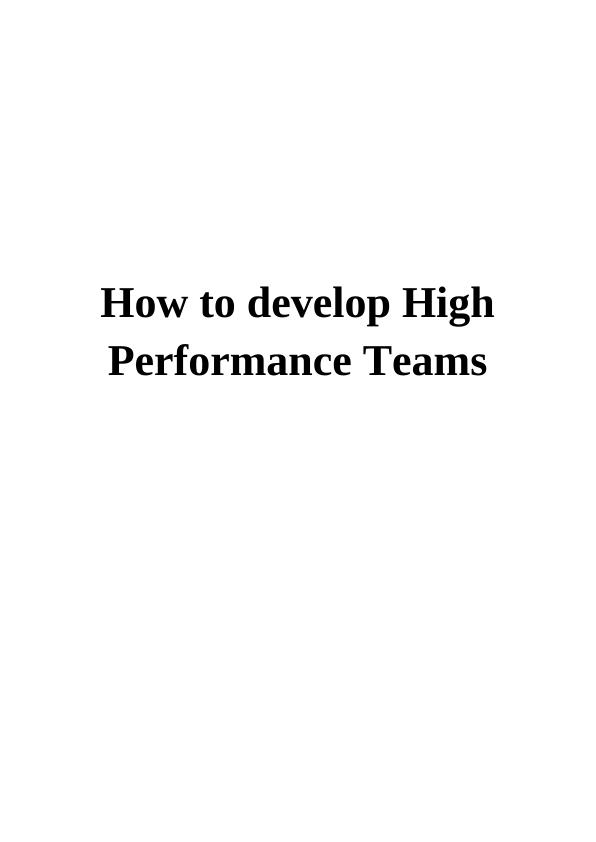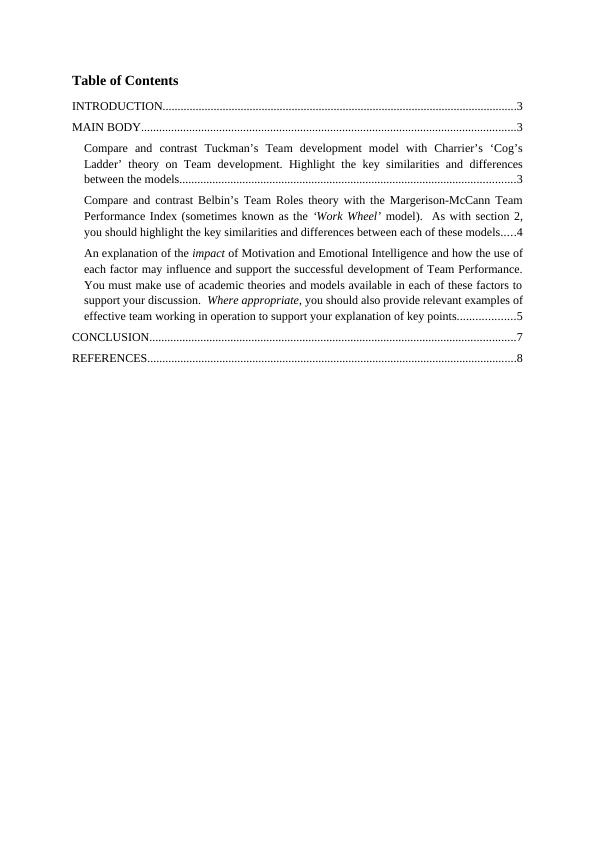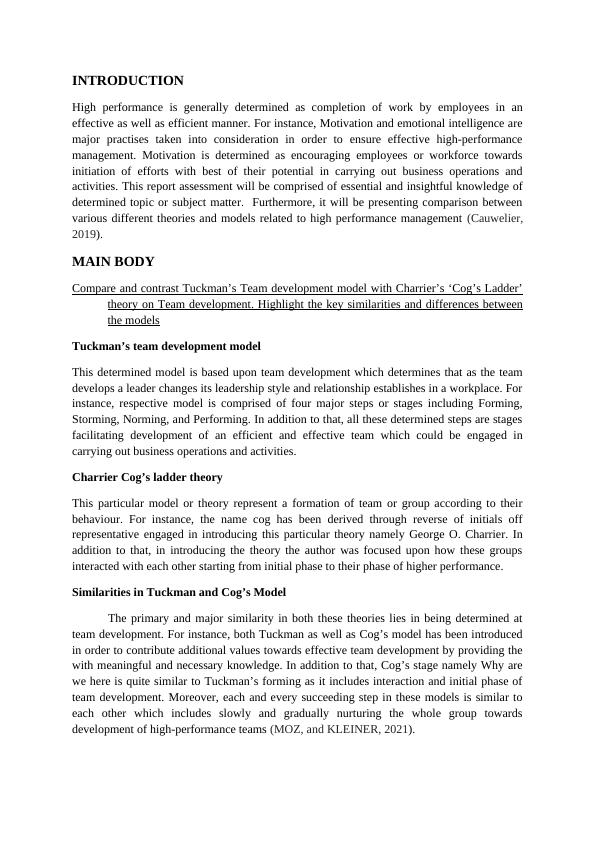Developing High Performance Teams: Theories and Models
Added on 2023-06-12
8 Pages2718 Words220 Views
How to develop High
Performance Teams
Performance Teams

Table of Contents
INTRODUCTION......................................................................................................................3
MAIN BODY.............................................................................................................................3
Compare and contrast Tuckman’s Team development model with Charrier’s ‘Cog’s
Ladder’ theory on Team development. Highlight the key similarities and differences
between the models................................................................................................................3
Compare and contrast Belbin’s Team Roles theory with the Margerison-McCann Team
Performance Index (sometimes known as the ‘Work Wheel’ model). As with section 2,
you should highlight the key similarities and differences between each of these models.....4
An explanation of the impact of Motivation and Emotional Intelligence and how the use of
each factor may influence and support the successful development of Team Performance.
You must make use of academic theories and models available in each of these factors to
support your discussion. Where appropriate, you should also provide relevant examples of
effective team working in operation to support your explanation of key points...................5
CONCLUSION..........................................................................................................................7
REFERENCES...........................................................................................................................8
INTRODUCTION......................................................................................................................3
MAIN BODY.............................................................................................................................3
Compare and contrast Tuckman’s Team development model with Charrier’s ‘Cog’s
Ladder’ theory on Team development. Highlight the key similarities and differences
between the models................................................................................................................3
Compare and contrast Belbin’s Team Roles theory with the Margerison-McCann Team
Performance Index (sometimes known as the ‘Work Wheel’ model). As with section 2,
you should highlight the key similarities and differences between each of these models.....4
An explanation of the impact of Motivation and Emotional Intelligence and how the use of
each factor may influence and support the successful development of Team Performance.
You must make use of academic theories and models available in each of these factors to
support your discussion. Where appropriate, you should also provide relevant examples of
effective team working in operation to support your explanation of key points...................5
CONCLUSION..........................................................................................................................7
REFERENCES...........................................................................................................................8

INTRODUCTION
High performance is generally determined as completion of work by employees in an
effective as well as efficient manner. For instance, Motivation and emotional intelligence are
major practises taken into consideration in order to ensure effective high-performance
management. Motivation is determined as encouraging employees or workforce towards
initiation of efforts with best of their potential in carrying out business operations and
activities. This report assessment will be comprised of essential and insightful knowledge of
determined topic or subject matter. Furthermore, it will be presenting comparison between
various different theories and models related to high performance management (Cauwelier,
2019).
MAIN BODY
Compare and contrast Tuckman’s Team development model with Charrier’s ‘Cog’s Ladder’
theory on Team development. Highlight the key similarities and differences between
the models
Tuckman’s team development model
This determined model is based upon team development which determines that as the team
develops a leader changes its leadership style and relationship establishes in a workplace. For
instance, respective model is comprised of four major steps or stages including Forming,
Storming, Norming, and Performing. In addition to that, all these determined steps are stages
facilitating development of an efficient and effective team which could be engaged in
carrying out business operations and activities.
Charrier Cog’s ladder theory
This particular model or theory represent a formation of team or group according to their
behaviour. For instance, the name cog has been derived through reverse of initials off
representative engaged in introducing this particular theory namely George O. Charrier. In
addition to that, in introducing the theory the author was focused upon how these groups
interacted with each other starting from initial phase to their phase of higher performance.
Similarities in Tuckman and Cog’s Model
The primary and major similarity in both these theories lies in being determined at
team development. For instance, both Tuckman as well as Cog’s model has been introduced
in order to contribute additional values towards effective team development by providing the
with meaningful and necessary knowledge. In addition to that, Cog’s stage namely Why are
we here is quite similar to Tuckman’s forming as it includes interaction and initial phase of
team development. Moreover, each and every succeeding step in these models is similar to
each other which includes slowly and gradually nurturing the whole group towards
development of high-performance teams (MOZ, and KLEINER, 2021).
High performance is generally determined as completion of work by employees in an
effective as well as efficient manner. For instance, Motivation and emotional intelligence are
major practises taken into consideration in order to ensure effective high-performance
management. Motivation is determined as encouraging employees or workforce towards
initiation of efforts with best of their potential in carrying out business operations and
activities. This report assessment will be comprised of essential and insightful knowledge of
determined topic or subject matter. Furthermore, it will be presenting comparison between
various different theories and models related to high performance management (Cauwelier,
2019).
MAIN BODY
Compare and contrast Tuckman’s Team development model with Charrier’s ‘Cog’s Ladder’
theory on Team development. Highlight the key similarities and differences between
the models
Tuckman’s team development model
This determined model is based upon team development which determines that as the team
develops a leader changes its leadership style and relationship establishes in a workplace. For
instance, respective model is comprised of four major steps or stages including Forming,
Storming, Norming, and Performing. In addition to that, all these determined steps are stages
facilitating development of an efficient and effective team which could be engaged in
carrying out business operations and activities.
Charrier Cog’s ladder theory
This particular model or theory represent a formation of team or group according to their
behaviour. For instance, the name cog has been derived through reverse of initials off
representative engaged in introducing this particular theory namely George O. Charrier. In
addition to that, in introducing the theory the author was focused upon how these groups
interacted with each other starting from initial phase to their phase of higher performance.
Similarities in Tuckman and Cog’s Model
The primary and major similarity in both these theories lies in being determined at
team development. For instance, both Tuckman as well as Cog’s model has been introduced
in order to contribute additional values towards effective team development by providing the
with meaningful and necessary knowledge. In addition to that, Cog’s stage namely Why are
we here is quite similar to Tuckman’s forming as it includes interaction and initial phase of
team development. Moreover, each and every succeeding step in these models is similar to
each other which includes slowly and gradually nurturing the whole group towards
development of high-performance teams (MOZ, and KLEINER, 2021).

End of preview
Want to access all the pages? Upload your documents or become a member.
Related Documents
Leading & Managing Effective Teams: Tuckman Team Model and Self-Development Strategieslg...
|10
|3074
|260
Analysis of Tuckman’s Model of Group Developmentlg...
|7
|1809
|77
Developing Successful Business Teamslg...
|22
|7052
|40
Facilitate Work Teams: Theories, Models, and Roleslg...
|7
|1852
|251
Reflection based on Tuckman Theorylg...
|5
|846
|1
Unlocking Team Success: Understanding Bruce Tuckman's Team Development Modellg...
|3
|1191
|113
